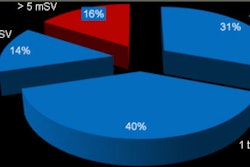Monday, November 28 | 11:20 a.m.-11:30 a.m. | SSC01-06 | Room S502AB
Chinese researchers are giving high marks to a new free-breathing 3D phase-sensitive inversion recovery (PSIR) turbo FLASH pulse sequence for detecting left ventricular myocardial scars in patients with coronary artery disease."The new 3D MR imaging [technique] can cover the entire left ventricle during one measurement rather than multiplanar multiple breath-holds when we use 2D PSIR turbo FLASH," said presenter Gang Yin, from Fuwai Hospital & Cardiovascular Institute. "The new approach can be executed during free breathing, which could be more suitable for patients with difficulty in breath-holding and could suppress respiratory artifact."
The study assessed 23 patients with prior myocardial infarction using segmented 2D and 3D PSIR turbo FLASH sequences for late gadolinium enhancement imaging in cardiac MR. Image quality was rated on a 0 to 3 scale, with 0 as poor and 3 as excellent with no artifacts.
While readers noted no differences in overall image quality in the hyperenhanced area and location, they concluded there was significantly greater mean hyperenhanced volume in 3D PSIR than in 2D PSIR.
Free-breathing 3D PSIR turbo FLASH is a "promising approach" to accurately assess left ventricular myocardial scar, especially in scar quantification, Yin and colleagues concluded.
"From the results of our study, we validated that the 3D acquisition can provide equivalent diagnostic information for late gadolinium enhancement qualitative (LGE) assessment and more scar volume for LGE quantitative assessment compared with 2D acquisition," Yin noted. "Since there is no gold standard of reference, we can't confirm that the volume result is absolutely correct. If it is proven by further research, it would be a landmark advancement for the prognosis of coronary artery disease."
The researchers hope to extend their current study to other areas of cardiomyopathy, such as hypertrophic cardiomyopathy, if possible.


.fFmgij6Hin.png?auto=compress%2Cformat&fit=crop&h=100&q=70&w=100)





.fFmgij6Hin.png?auto=compress%2Cformat&fit=crop&h=167&q=70&w=250)











